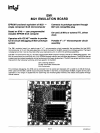
INTELLEC PROMPT 48
Documentation
The
PROMPT
48
manual Includes chapters for the
reader with
little or
no
programming experience. Topics
treated range from number systems to microcomputer
hardware design. A
novel, unifying set of tutorial
diagrams -
MICROMAPS - simplify microcomputer
SPECIFICATIONS
Timing
Basic Instruction -
2.5
,..s
Cycle Time -
tCY
= 2.5,..s
Clock
- 6 MHz ± 0.1%
Memory Bytes
The
8748
contains
64
bytes of register memory,
no
ex-
ternal data memory, and
1024
bytes of
RAM
program
memory.
The
PROMPT
system provides
256
bytes of
ex-
ternal data memory, and
1024
bytes of
RAM
program
memory.
PROMPT
RAM
program memory
can
be
used
in
place of the on-chip
EPROM
program memory; thus
programs
less than
1024
bytes may
be
designed. For
larger programs additional memory
can
be
directly
In-
terfaced to the
MCS-48
bus via the
PROMPT
panel
I/O
ports
and
bus connector.
Memory Configuration
Memory
Maximum
On
Chip
In PROMPT 48
Reglsler
64 64
0
Dala
3328
0 256
Program
4006 1024 EPROM 1024 RAM
1/0
Ports
All
MCS-48
I/O
ports are accessible
on
the
PROMPT
panel connector.
Bus - A true bidirectional 8-bit port with associated
strobes.
If the bidirectional feature is not needed, bus
can
serve
as
either a statically latched output port or a
non-latching Input port.
Input
and
output lines cannot
be
mixed.
Ports 1
and
2 - Data written to these 8-bit ports is
latched
and
remains unchanged until written.
As
Inputs
these
lines
are
not latching.
The
lines of ports 1
and
2
are
called quasi bidirectional. A special output structure
allows
each
line
of
port 1
and
half of port 2 to serve
as
an
input,
an
output, or both.
Any
mix of input, output,
and
both lines is allowed.
TO,
n,
and
INT - Three pins that
can
serve
as
Inputs.
TO
can
be
designated
as
a clock output. Input/output
can
be
expanded via the
PROMPT
panel connector with a
special
I/O
expander
(8243)
or standard peripherals.
Reset and Interrupts
Relit
- Initializes the
PROMPT
system and enters the
monitor.
Monitor
Interrupt - exits a user program gracefully,
preserving system status and entering the monitor.
10-11
concepts. PROMPT's handy, pocket-sized reference
card
let can
be
affixed to the mainframe. Programming
pads aid in the organization
and
documentation of
pro-
grams. These features, plus a comprehensive design
library
of
manuals, articles, and application notes,
make the
Intellec
PROMPT
48
ideal for the newcomer to
mlcrocomputlng.
User Interrupt - causes
an
Interrupt only If the
PROMPT
system
Is
running a user program.
The
processor traps to location 3
1
6.
The
MCS-48
timer/-
event counter is not used
by
the
PROMPT
system
and
is
available to the user. Either timer flag or interrupt will
signal
when
overflow
has
occurred.
The
timer interrupt
can
be
used only
in
the go-no-break (real time) mode.
EPROM
Programming
PROMPT
48
provides a programming socket to directly
program
8748s.
Programs
are
loaded Into the
PROMPT
RAM
program memory via keyboard.
EPROM,
teletype-
writer, or other serial interface. A fail-safe interlock
ensures programming
pulses
are
applied only if the
device is properly inserted. Inadvertant reprogramming
is prevented
by
a read-before-write programming algo-
rithm.
Each
location
may
be
individually programmed,
one byte at a time.
Panel
1/0
Ports and Bus Connectors
All
MCS-48
pins, except five,
are
accessible
on
the
I/O
ports
and
bus connector.
The
five reserved for
PROMPT
system control
are
EA
external access,
SS
single step,
X1,
X2
crystal Inputs, and
5V.
Due
to internal buffering
of the
MCS-48
bus,
access times will
be
negligibly
degraded
by
the
PROMPT
system. Since
MCS-48
pro-
cessors do not communicate internal address gate
status, bus data must
be
driven out If neither
PSEN
nor
RD
is asserted.
System Devices'
Both user programs and the
PROMPT
monitor enjoy ac-
cess to system devices: serial
I/O,
panel displays, and
keyboard. These are memory-mapped to program
memory addresses beyond
2K.
Serial
I/O
-
The
serial
I/O
port (data
820
16
, control
821
1
6)
Is
defined
by
software
and
jumpers for
110
baud,
20
mA
current loop, but
can
easily
be
jumpered for other baud
rates
and
RS232C
levels. Asynchronous or synchronous
transmission, data format,
control characters,
and
par-
ity
can
be
programmed.
Panel Displays - Eight display ports (data
810-817
1
sl
allow each of the panel displays to
be
written from user
programs. Data written
on
a display device will time out
after a fixed interval. Displays must
be
refreshed on a
polled or interrupt-driven basis. User programs
can
call
software drivers which provide this
capability.
AFN-00352A-05


















